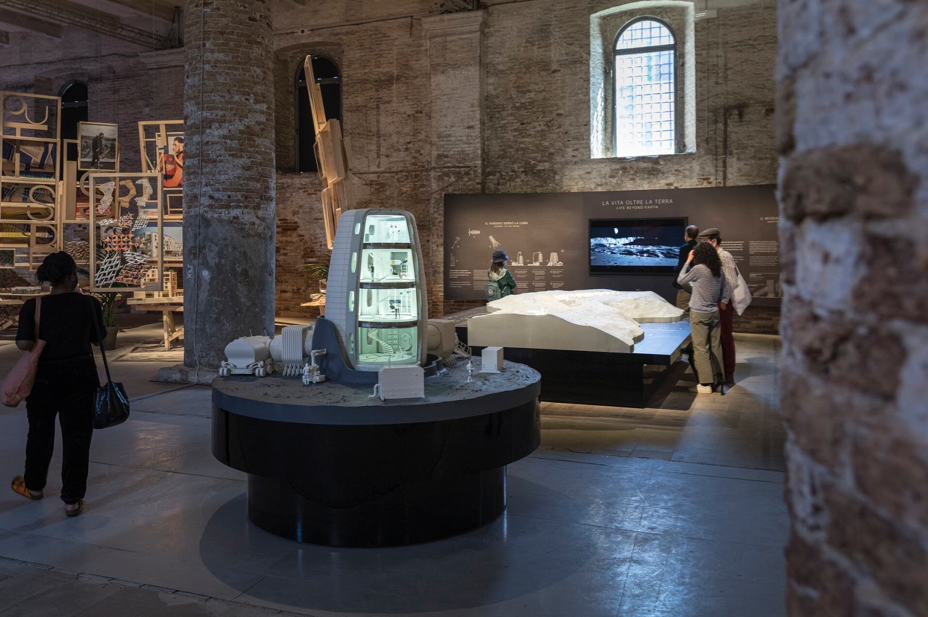The “17th International architecture Exhibition of Venice” is one of the first international events opening in time of COVID-19. The open question that Hashim Sarkis, the artistic director of the current Biennale Architettura, articulates in his proposal seems to be a particularly fitting one. Certainly, it does not disclose an original and recent field of inquiry but, as the dean of the MIT (Massachusetts Institute of Technology) and founder of his homonymous studio, Hashim Sarkis Studios, stated, it draws back to Aristotle, Rousseau and Rawls. The current Biennale is a research-driven exhibition into the social and architectural contract which regulates possible coexistences among human and non-human beings. The interrogative proposed is one of those kinds which never gets exhausted once someone finds the ideal answer to it, admitting that an ideal response is even possible. This generates a feeling of frustration in the visitor who is often asked to confront densely written academic projects, alternated by conceptual artistic installations. Nonetheless, the overall structure imposed by its artistic director surely helps to survive what could have been a sequence of bland opinions on urgent planetary issues. Contemporary issues such as migration, climate changes, access to technology and basic human rights—and not limited to them—unfold multiple times across the exhibition according to different lenses, alternately zooming in and out from the theme concerned.
The five scales suggested depart from the body, as in the section Among Diverse Beings, and approach an extraterrestrial dimension, as indicated by the section’s title As One Planet. In his own choices of scales to work with, Sarkis does not admit any pre-given forms of community tied, for example, to nation-state’s borders. Our coming together gets defined and reinvented, case by case, throughout the exhibition; architects, landscape and urban designers seem to have a primary role in this task. They analyze, problematize and subvert spaces, on which an expanding notion of community relies for its becoming. As the result of collaborative research between universities, the project Your Restroom is a Battleground toilet (2021), installed between the Arsenale and the toilettes at the Giardini, illustrates case studies where hygienic services became the site for social and political vindications. The project Life Beyond Earth (2020) by Skidmore, Owings and Merrill in collaboration with the European Space Agency, presents a master plan for a Moon Village, where an international community is the initiator of a sustainable lifestyle on the surface of the Earth’s satellite.

BIT.BIO.BOTA Collective Experiment in Biotechnological Architecture, 2021, ecoLogicStudio (Claudia Pasquero, Marco Poletto, UK 2005) in partnership with Synthetic Landscape Lab of Innsbruck University (Austria, 2017) and Urban Morphogenesis Lab, Bartlett UCL (UK, 2012) ©Marco Cappelletti
Many projects included in the exhibition emphasize the interdisciplinary essence of today’s architecture, a field of research capable of activating collaborations among professionals from the most diverse disciplines. BIT.BIO.BOT (2021), for example, is an urban laboratory designed by ecoLogicStudio for the cultivation of Spirulina platensis, an alga that recently received commercial attention for its multiple beneficial properties, in an artificial habitat. The project combines research in the fields of advanced architecture and microbiology. The “17th International Architecture Exhibition of Venice” mirrors an architecture seduced by its activist factions. The studio Arquitectura Expandida explores alternative forms of community gathering through self-organization and the occupation of public spaces, in the peripheral neighborhoods of Bogotà. Sarkis’s Biennale urges the visitor to engage with an ecosystem of ideas that stretches from the borderlands to indigenous thinking. In OCA RED (2021), a celebration of the indigenous way of living together with nature emanates from the images created by Takumã Kuikuro, an internationally recognized film director who grew up in the Alto Xingú Indigenous Territory. The ancestral knowledge belonging to Brazilian native communities becomes a source of inspiration for the preservation and regeneration of biodiversity worldwide.
Overall, How Will We Live Together? encourages a radical paradigm shift from a human-centered architecture to a way of designing cities, buildings and landscapes that correspond to the projections of a plurality of beings. However, in a society where the term togetherness has often made people blind in front of the yet-to-be travelled distance from the current situation to the effective mutual and respectful openness toward each other, it might be asked whether this biennial sufficiently exposes the unspoken inequalities that are often reproduced in our coming together. And, if it does so, not less important for our considerations are the manners through which the exhibition makes itself accountable for their representations. An atmosphere of optimism stems from the title of the Biennale and reaches the words of its artistic director. In his official presentation of the theme of the Biennale, Sarkis suggests that it is because of “the optimism that drives architecture and architects” that possible answers to his open question can be advanced. Ultimately, it is up to visitors to wonder whether this optimism will enable us to transform a kind of thinking, certainly led by the best intentions, into further coherent actions capable of redefining the way we live in proximity.


